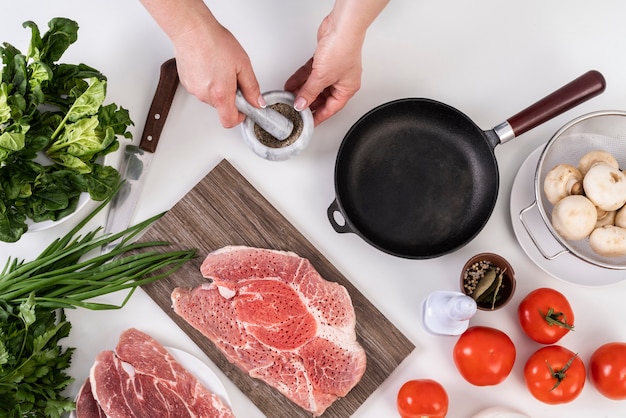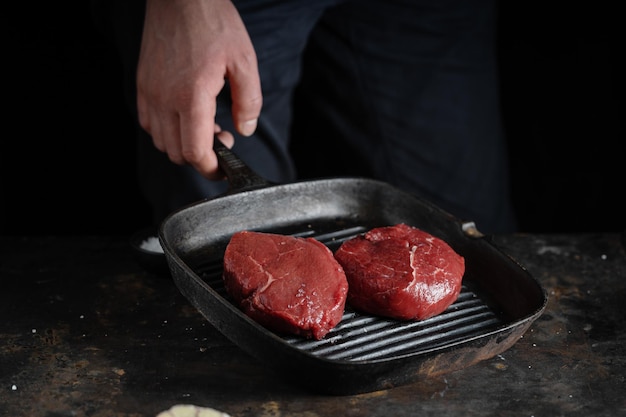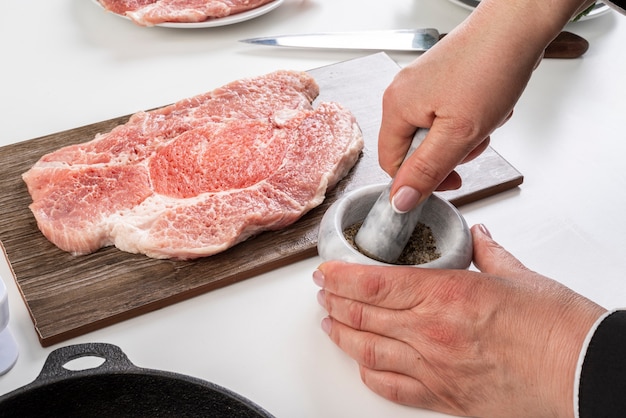Let's face it, eye of round steak can be a bit of a culinary mystery. It's often seen as a tough, dry cut, but believe me, it's a hidden gem waiting to be unlocked! I've been cooking for years, and I've made my fair share of eye of round mistakes. Overcooked, tough, dry - you name it, I've done it. But with a little practice and the right knowledge, this cut can become a star in your kitchen.
So, grab your apron, get those ingredients ready, and let's dive into the world of perfectly cooked eye of round steak.
(Part 1) Understanding Eye of Round Steak

Before we get our hands dirty, let's take a closer look at the star of the show. Eye of round steak comes from the hindquarters of the cow, specifically the round. This muscle is a powerhouse for the animal, responsible for all those long walks and runs. This makes it a lean cut, which is great for health-conscious eaters, but it also means it can be tough if not cooked correctly.
The Lean, Mean, and Sometimes Tough Machine
Think of eye of round steak as the marathon runner of the beef world. It's lean, packed with flavour, and budget-friendly, but it requires a little more TLC than some of its more pampered cousins.
The Secret to Tenderness
The key to unlocking the true potential of eye of round steak is to embrace its leanness and play to its strengths. Think low and slow, like a simmering stew on a cold day. This gentle approach gives the muscle fibres time to relax, creating a wonderfully tender and flavorful final product.
(Part 2) Preparing Your Steak for Success

Now that you know what you're working with, it's time to prepare your eye of round steak for its culinary journey.
choosing the right cut
When you're at the butcher's, ask for a piece of eye of round steak that's about 1-1.5 inches thick. Avoid anything too thin or too thick, as it will be harder to cook evenly.
Trimming the Fat
Eye of round steak usually has a thin layer of fat on it, but we're going to trim most of it off. This is because fat can make the meat tougher, especially when cooking low and slow. Use a sharp knife to carefully trim the fat, leaving just a thin layer on the surface. Think of it as giving the steak a bit of a spa treatment before the big event.
Patting it Dry
Once you've trimmed the fat, pat the steak dry with paper towels. This will help it brown nicely and prevent the moisture from steaming, leading to a more evenly cooked steak.
(Part 3) The Power of Marinating

Marinating eye of round steak is a game-changer. It's a simple step that infuses flavour and tenderness into the meat. The acidic ingredients in marinades help break down those tough muscle fibres, creating a more tender and flavorful final product. I've tried countless marinades over the years, and these are my go-to recipes:
1. Classic Italian Marinade: Simple Elegance
This is the perfect marriage of herbs, garlic, and acidity, creating a classic Mediterranean flavour profile.
- 1/2 cup olive oil - For richness and flavour
- 1/4 cup red wine vinegar - Adds brightness and helps tenderize the meat
- 2 cloves garlic, minced - The foundation of Italian flavour
- 1 teaspoon dried oregano - Earthy and aromatic
- 1 teaspoon dried basil - Adds a touch of sweetness
- 1/2 teaspoon salt - Enhances the flavour
- 1/4 teaspoon black pepper - A touch of heat
Combine all ingredients in a bowl and whisk until well combined. Pour the marinade over the steak and let it marinate in the fridge for at least 2 hours, or up to overnight.
2. Spicy Citrus Marinade: A Zingy Adventure
This marinade is bursting with flavour, combining citrusy notes with a fiery kick.
- 1/2 cup orange juice - Brings a vibrant acidity and sweetness
- 1/4 cup soy sauce - Adds depth of flavour and umami
- 2 tablespoons honey - Rounds out the flavours and adds a touch of sweetness
- 1 tablespoon grated ginger - A warm and aromatic addition
- 1 tablespoon minced garlic - Essential for depth of flavour
- 1 teaspoon red pepper flakes - Provides a spicy kick
Mix all the ingredients in a bowl and whisk until well combined. Pour the marinade over the steak and let it marinate in the fridge for at least 2 hours.
3. The "No-Fuss" Marinade: When Time is Tight
This quick marinade is perfect for busy nights when you need a flavour boost without a long wait.
- 1/4 cup olive oil - Adds richness and flavour
- 2 tablespoons lemon juice - Brightens the flavour profile
- 1 clove garlic, minced - A simple and effective flavour enhancer
- 1/2 teaspoon salt - Balances the flavours
- 1/4 teaspoon black pepper - Adds a touch of heat
Combine all ingredients in a bowl and whisk until well combined. Pour the marinade over the steak and let it marinate in the fridge for at least 30 minutes.
(Part 4) Cooking Your Steak: The Low and Slow Approach
Now that your steak is prepped and ready to go, it's time for the main event. Low and slow cooking is the key to unlocking the tender, juicy secrets of eye of round steak. Don't worry, you don't need a fancy slow cooker for this.
1. Oven Cooking: Simple and Reliable
Preheat your oven to 325°F (160°C). Place the marinated steak in a roasting pan and pour any remaining marinade over it. Cover the pan tightly with foil, creating a steamy haven for your steak. Bake for 1.5 to 2 hours, or until the internal temperature reaches 145°F (63°C) for medium-rare.
2. The Dutch oven method: A Kitchen Classic
This is my go-to method for cooking eye of round steak. The dutch oven seals in moisture, creating a succulent and flavorful result.
Preheat your oven to 300°F (150°C). Get your Dutch oven nice and hot over medium heat. Sear the steak for 2-3 minutes per side, or until nicely browned. Add 1 cup of beef broth to the bottom of the Dutch oven, creating a flavorful base. Cover the Dutch oven tightly with a lid and transfer to the oven. Cook for 1-1.5 hours, or until the internal temperature reaches 145°F (63°C) for medium-rare.
(Part 5) The Art of Resting
Patience is key when cooking eye of round steak. Once it's cooked to perfection, let it rest for at least 10 minutes before slicing and serving. This allows the juices to redistribute throughout the meat, resulting in a more tender and juicy steak.
Why Resting is Crucial
Think of it like letting a delicious cake cool down after baking. It allows the flavours to meld and the texture to settle, creating a more enjoyable experience.
Making the Most of Your Time
While your steak is resting, take advantage of the downtime and prepare your favourite sides. A simple salad, roasted vegetables, or mashed potatoes would pair beautifully with your perfectly cooked eye of round steak.
(Part 6) Slicing and Serving: The Finishing Touches
You've done the hard work, and now it's time to enjoy the fruits of your labour. Slicing eye of round steak is a bit different than slicing a thick steak, so pay close attention.
The Right Way to Slice
The key is to slice your eye of round steak thinly, against the grain. This means slicing perpendicular to the muscle fibres. This will make the meat more tender and easier to chew.
Serving Ideas: From Classic to Creative
Now for the fun part - serving your delicious creation!
- Classic: Serve your sliced steak with your favourite sides like mashed potatoes, roasted vegetables, or a simple green salad.
- Fancy: Create a beautiful platter with sliced steak, arugula, sliced cherry tomatoes, crumbled feta cheese, and a balsamic glaze drizzled on top.
- Sandwich Style: Use the sliced steak in a sandwich, piled high with your favourite toppings.
(Part 7) Mastering the Internal Temperature: Your Doneness Guide
Now, let's get specific about doneness. We've been talking about "medium-rare", but how do you know when your steak is cooked to your liking? This is where your trusty meat thermometer comes in handy.
Understanding the Levels of Doneness
Here's a quick guide to the internal temperatures for different levels of doneness:
| Doneness | Internal Temperature (°F) | Internal Temperature (°C) |
|---|---|---|
| Rare | 125-130 | 52-54 |
| Medium-Rare | 130-135 | 54-57 |
| Medium | 140-145 | 60-63 |
| Medium-Well | 150-155 | 65-68 |
| Well Done | 160 | 71 |
Using a Meat Thermometer: A Key Skill
A good meat thermometer is essential for cooking eye of round steak to perfection. Insert the thermometer into the thickest part of the steak, making sure it doesn't touch any bone. The internal temperature should read between 130°F and 135°F for medium-rare.
(Part 8) FAQs: Your Eye of Round Questions Answered
I know you might have some questions about this unique cut, so let's address them head-on.
1. Can I Freeze Eye of Round Steak?
Absolutely! Just make sure to wrap it tightly in plastic wrap or freezer paper to prevent freezer burn. It can be stored in the freezer for up to 3 months.
2. How Can I Make My Eye of Round Steak More Tender?
We've already touched on the importance of low and slow cooking. Marinating is another fantastic way to tenderize the steak. Another trick is to use a meat mallet to pound the steak before cooking. This will help break down the muscle fibres and make the meat more tender.
3. Is Eye of Round Steak Good for Stir-Fries?
Yes, it can work well in stir-fries, but you need to be strategic. Slice it thinly against the grain, and cook it quickly over high heat. It's a lean cut, so it can dry out if cooked too long, but it holds its texture well when cooked quickly.
4. Can I Cook Eye of Round Steak on the Grill?
You can, but it's best to use a slow and low grilling method. This will prevent the steak from drying out. I prefer oven or Dutch oven methods for eye of round steak, but if you must grill, use low heat and a cover to keep the steak moist.
5. What Can I Do With Leftover Eye of Round Steak?
Leftover eye of round steak is a culinary chameleon! It's perfect for sandwiches, salads, or even a tasty pasta dish. Slice the steak thinly and add it to your favourite recipe.
(Part 9) My Personal Takeaways: Eye of Round Steak is a Winner!
When I first started cooking, I was a bit intimidated by eye of round steak. It seemed like such a tough cut. But over time, I've learned that with the right techniques, it can be a real star in the kitchen. It's lean, versatile, and budget-friendly. Once you master the low and slow method, you'll be making this steak all the time. It's truly become a staple in my own kitchen.
I hope you find this guide helpful and inspiring. Remember, don't be afraid to experiment with different marinades and cooking methods to find what works best for you. Happy cooking!
Everyone is watching

Prime Rib Roast Cooking Time Chart: Per Pound Guide
Cooking TipsPrime rib roast. Just the name conjures images of lavish dinners, crackling fires, and hearty laughter. It’s ...

How Long to Bake Potatoes in the Oven (Perfect Every Time)
Cooking TipsBaked potatoes are a staple in my kitchen. They're incredibly versatile, delicious, and surprisingly easy to m...

Perfect Rice Every Time: The Ultimate Guide to Cooking Rice
Cooking TipsAs a self-proclaimed foodie, I've always been a bit obsessed with rice. It's the foundation of countless cuisi...

The Ultimate Guide to Cooking Asparagus: Tips, Techniques, and Recipes
Cooking TipsAsparagus. The mere mention of this spring delicacy conjures up images of vibrant green spears, crisp and burs...

Ultimate Guide to Cooking the Perfect Thanksgiving Turkey
Cooking TipsThanksgiving. Just the word conjures up images of overflowing tables laden with delicious food, the scent of r...
